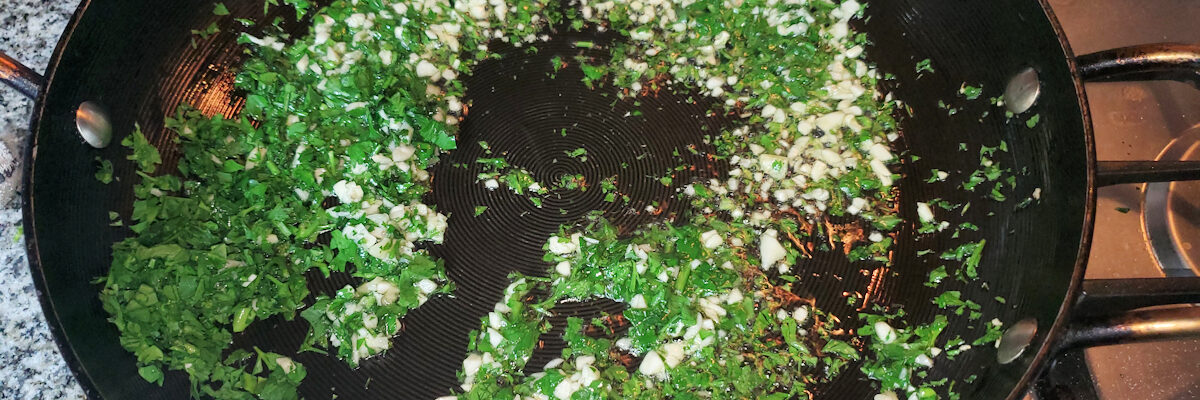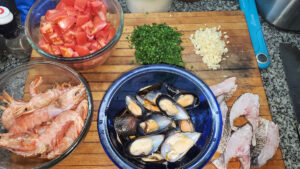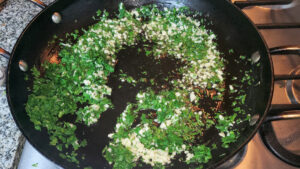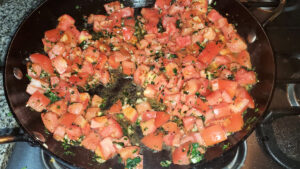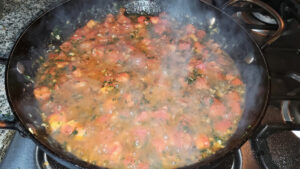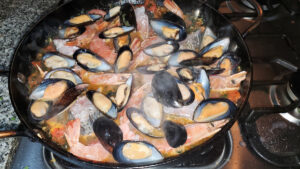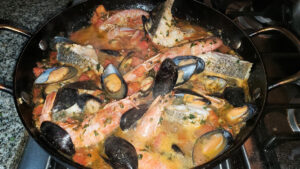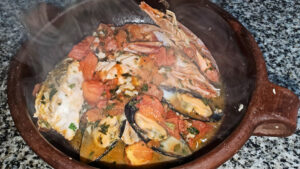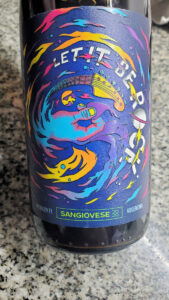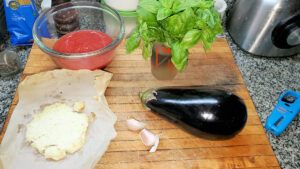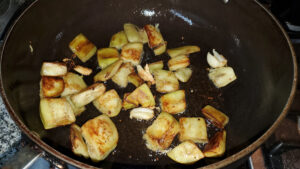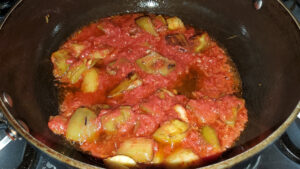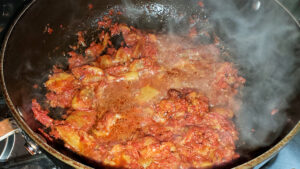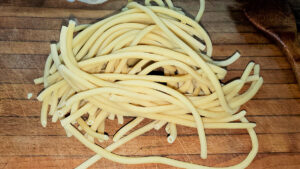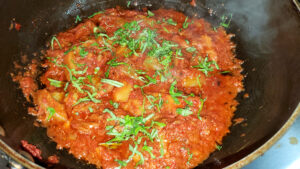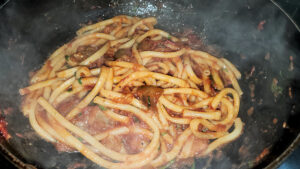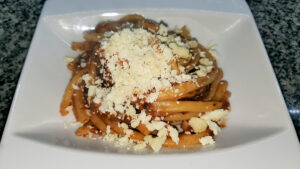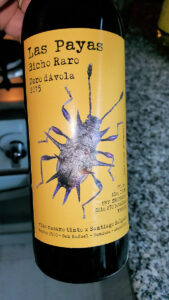On to our last entry for this season’s airing of our man Stan’s tromping about in Italy. In the fifth and sixth episodes he heads to Tuscany and Sicily. All past comments on the show could be repeated here, so I won’t. Let’s go straight to the food.
In Tuscany we get our kitchen demo in the city of Livorno, on the coast, where he is informed that he’s being treated to the local fisherman’s stew, Cacciucco (pronounced more or less “cachooko”). However, he is informed, it’s not quite a real cacciucco because a) it’s being made by someone who’s not from the area, and therefore couldn’t possibly be the real thing, and b) it’s being fancied up with lobster taking the center place. We don’t have lobsters here, so that part was out the window.
Now, of course, as with any of these longstanding traditional dishes, there are a zillion versions of it. Just by way of comparing, I did a quick google search for the “traditional recipe for cacciucco” and got the following results for the first ten entries:
- Base of onion, garlic, celery, chili flakes, fennel seed, sage; red wine; tomato passata; fish stock; 3 types of fish, mussels, clams, prawns, baby octopus, squid.
- Base of garlic, chili flakes, parsley, sage; white wine; tomato paste and canned tomatoes; fish stock; 2 types of fish, shrimp, mussels
- Base of onion, garlic, celery, chili flakes, parsley, sage; red wine vinegar; fresh tomatoes; water; “mixed fish and/or seafood”
- Base of onion, carrot, celery, chilies, garlic, parsley; white wine; fresh tomatoes; water; 5 types of fish, shark, cuttlefish, octopus
- Base of chilies and garlic, no herbs; white wine; canned tomatoes; shark, octopus, cuttlefish, squid; and separately cook 1 type of fish with celery and white wine; then mix the two preparations to serve
- Base of onion, garlic, chili flakes, parsley, basil; white wine; peeled fresh tomatoes; clam juice; 2 types of fish, shrimp, squid, scallops
- Base of whole unpeeled garlic cloves and sage, browned in oil just long enough to flavor it, then removed; red wine; canned tomatoes; 2 types of fish, octopus, cuttlefish, prawns, mussels
- Base of onion, garlic, chili flakes, fennel seeds, parsley; red wine; fresh tomatoes; no extra liquid; mixed fish and shellfish
- Base of onion, garlic, chili flakes, dry oregano and basil; no wine; tomato sauce; shellfish stock; no fish, just mussels and shrimp
- Base of onion, carrot, celery, lots of garlic, whole dried chilies; white wine; fresh tomatoes; vegetable stock; mixed fish, squid, prawns
I imagine if I kept going the list would keep getting longer, and with more and more variations. About the only thing in common seems to be garlic, albeit in different ways, some kind of herbs, usually parsley or sage or both, usually wine of some sort, tomatoes in some form, and a mix of fish and/or shellfish. But that could easily apply to a whole number of different fish stews out there in the world.
The version in the show is very simple, and unless they did it off camera and didn’t mention it, it didn’t include anything but garlic, parsley, tomatoes, 1 kind of fish, mussels, prawns, and the aforementioned by not being included, lobster. I assume, as always, salt and pepper, but not more than that. That was interesting in and of itself, because Tucci pointed out repeatedly in the episode that a sofrito base of onions, celery, and carrots is almost mandatory in all Tuscan dishes, and he didn’t even comment on the lack of those in making this dish.
Lots of garlic and lots of parsley. Sautéed over low heat in a good amount of olive oil for about five minutes.
Chopped fresh tomatoes, at this point I added salt and pepper.
Cook down until the tomatoes are falling apart, about ten minutes.
Add the fish steaks, prawns, and mussels, nestle them all down into the pan and cook them through – about five minutes at a steady simmer.
And… done. Adjust the seasoning.
Serve it up. Now, it’s good. I really like the extra intensity that this quantity of garlic and parsley bring to the dish – far more in it than any of the recipes above included, and more than the recipe I learned years ago. On the other hand, for me it’s really missing the complexity you get from a sofrito and the wine, the heat from a touch of chili, and more variety of fish and shellfish.
Had the cacciucco with a local Sangiovese, the classic red grape of Tuscany, from Mendoza producer Proyectos con Locura SAS, their 2020 Sangiovese “Let it be Rock”. It was recommended by one of my neighborhood wine merchants who I’ve come to trust his judgement and despite the garish label, it’s a really excellent Sangiovese, almost tasting of a classic Italian Chianti – “Black cherry, graphite, hint of smokiness. Moderately high acidity, light to medium body, green tannins, medium finish.” It’s a little young as a 2020, I think it’ll likely be more interesting in about a year. 900 pesos, or a little under $10.
On to Sicily!
The most iconic pasta of the island is easily Pasta alla Norma. Here, Tucci heads to a local winery that has a restaurant at it, and the chef whips up the “many generations family recipe” for this dish. Another one that’s about as simple as it gets, other than one ingredient that takes a little work. We have garlic, eggplant, basil, tomato passata, and… baked ricotta. That takes a little time in advance – and I’ve not encountered it before to be used in this way. I’ve certainly had dishes that were baked with ricotta in them, like a lasagna, or even a pizza, but here the ricotta is spread out on baking paper and baked in a low heat oven for about an hour and a half until it starts to brown, and it becomes very dry and crumbly. It also tastes delicious!
Peel the garlic cloves and just lightly crush them. Peel the eggplant and cut it in bite sized pieces. Sauté both together in a good amount of olive oil until the eggplant is browned.
Add the tomato passata, a little salt and pepper, turn the heat down low, and cook this for an hour, stirring now and then. What will happen is it will turn into almost a paste, and the eggplant and garlic will completely break down.
When it reaches this point, get your pasta boiling – the traditional pasta for this dish is fresh maccheroni, which is a thinner and longer version to the American elbow macaroni. Being fresh, this only takes about two minutes to cook in boiling salted water. Add a scoop of the pasta water to the sauce paste and give it a good stir to emulsify it a bit and thin it out. Adjust the seasoning with salt and pepper if needed.
Cut the basil in thin strips – chiffonade as the French say – and add it and the maccheroni into the pan, toss to coat well and finish cooking the pasta, about a minute. If it seems a little stodgy, add a splash more of the pasta water.
And, serve. Crumble the baked ricotta over the top.
I’m of two minds about this one. And again, a zillion versions out there no doubt, though probably fewer variations given the limited ingredients. The way I learned it had a touch of chili flakes in it, and it was only cooked for a few minutes to just barely start breaking down the tomatoes and eggplant (pre-fried), and a splash of wine thrown in, and finished with some fresh ricotta and grated pecorino. On the minus side for me, I missed the bit of heat from the chili. But I really like the slow cooking and the concentration of flavor, plus the way the vegetables break down completely and become a thick sauce that clings to the pasta. And I love the baked ricotta versus the fresh ricotta and grated pecorino. I’d happily make this version again, just adding in a good pinch of chili to it.
This one took some finding. The classic red grape of Sicily is Nero d’Avola, and I’d never heard of one being made here in Argentina. But a search turned up one wine being produced, and one vineyard recently planted and soon to be produced. I got in contact with the winery owner of the first and it turned out they are partnered with a wine bar/shop in Palermo that had their wines. Interestingly, Las Payas “Bicho Raro” Nero d’Avola 2015 only comes in a half-bottle, along with several other Italian and French off-beat grape varieties. And, the shop only sells them in a six-pack, with one each of six different varieties. So I have a little lineup of these to try over time – some will probably show up in future Tucci postings, though this round of bottles aren’t going to be packed away until future season. I love this wine, absolutely spot on and delicious – “Prune, milk chocolate, green peppercorns. Medium body, moderate acidity, dry tannins, long finish.” 350 pesos, or about $4, for a half-bottle.
